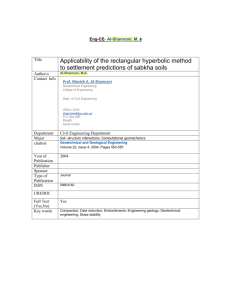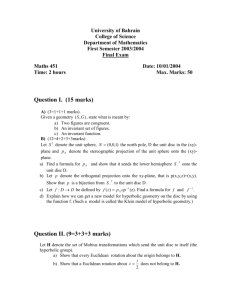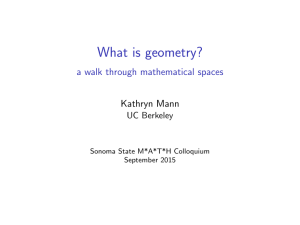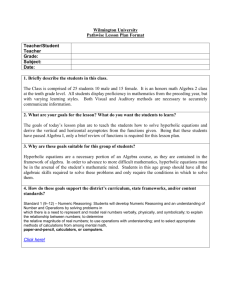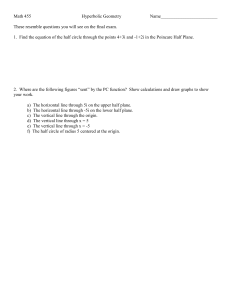Hypershot: Fun with Hyperbolic Geometry
advertisement
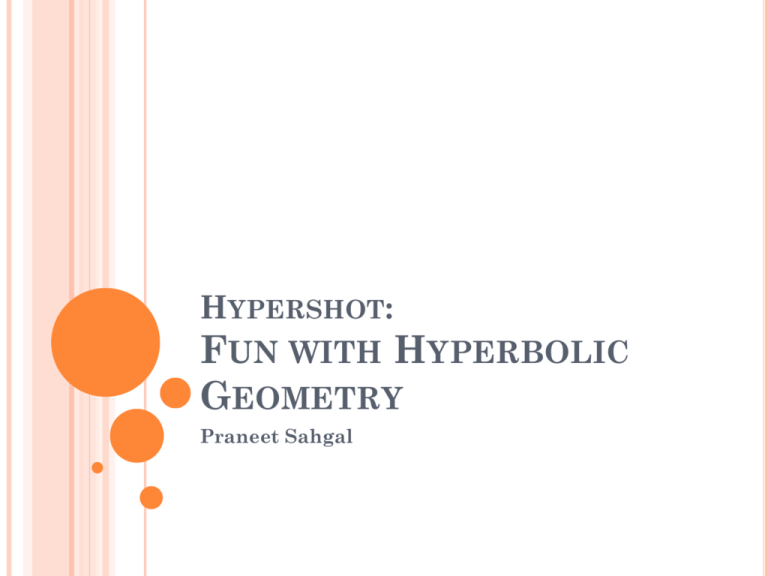
HYPERSHOT: FUN WITH HYPERBOLIC GEOMETRY Praneet Sahgal MOTIVATION FOR HYPERBOLIC GEOMETRY Euclid’s 5 Axioms: 1. A straight line segment can be drawn joining any two points. 2. Any straight line segment can be extended indefinitely in a straight line. 3. Given any straight line segment, a circle can be drawn having the segment as radius and one endpoint as center. 4. All right angles are congruent. 5. If two lines are drawn which intersect a third in such a way that the sum of the inner angles on one side is less than two right angles, then the two lines inevitably must intersect each other on that side if extended far enough. This postulate is equivalent to what is known as the parallel postulate. Source: http://mathworld.wolfram.com/EuclidsPostulates.html MOTIVATION FOR HYPERBOLIC GEOMETRY What if we tweak that last axiom, the Parallel Postulate? 1. Say there aren’t ANY parallel lines (spherical geometry) 2. Say there’s MORE THAN ONE parallel line (hyperbolic geometry) Note: There’s actually infinite parallel lines in hyperbolic space MODELING HYPERBOLIC GEOMETRY Upper Half-plane Model (Poincaré half-plane model) Poincaré Disk Model Klein Model Hyperboloid Model (Minkowski Model) Image Source: Wikipedia UPPER HALF PLANE MODEL Say we have a complex plane We define the positive portion of the complex axis as hyperbolic space We can prove that there are infinitely many parallel lines between two points on the real axis Image Source: Hyperbolic Geometry by James W. Anderson POINCARÉ DISK MODEL Instead of confining ourselves to the upper half plane, we use the entire unit disk on the complex plane Lines are arcs on the disc orthogonal to the boundary of the disk The parallel axiom also holds here Image Source: http://www.ms.uky.edu/~droyster/courses/sp ring08/math6118/Classnotes/Chapter09.pdf KLEIN MODEL Similar to the Poincaré disk model, except chords are used instead of arcs The parallel axiom holds here, there are multiple chords that do not intersect Image Source: http://www.geom.uiuc.edu/~crobles/hyperbolic/hypr/modl/kb/ HYPERBOLOID MODEL Takes hyperbolic lines on the Poincaré disk (or Klein model) and maps them to a hyperboloid This is a stereographic projection (preserves angles) Maps a 2 dimensional disk to 3 dimensional space (maps n space to n+1 space) Generalizes to higher dimensions Image Source: Wikipedia MOTION IN HYPERBOLIC SPACE Translation in x, y, and z directions is not the same! Here are the transformation matrices: x-direction y-direction z-direction To show things in 3D Euclidean space, we need 4D Hyperbolic space THE PROJECT Create a system for firing projectiles in hyperbolic space, like a first person shooter Provide a sandbox for understanding paths in hyperbolic space REFERENCES http://mathworld.wolfram.com/EuclidsPostulates. html Hyperbolic Geometry by James W. Anderson http://mathworld.wolfram.com/EuclidsPostulates. html http://www.math.ecnu.edu.cn/~lfzhou/others/cann on.pdf http://www.geom.uiuc.edu/~crobles/hyperbolic/hy pr/modl/kb/

